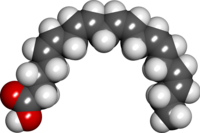
Photo from wikipedia
The instability of polyunsaturated fatty acids to peroxidation often hinders the practical application of oil-based products, and oil-in-water (o/w) emulsions are important components of a wide range of drugs, functional foods… Click to show full abstract
The instability of polyunsaturated fatty acids to peroxidation often hinders the practical application of oil-based products, and oil-in-water (o/w) emulsions are important components of a wide range of drugs, functional foods and consumer care products. Caffeic acid (CA)-grafted chitosan (CA-g-Ch) was successfully synthesized as a novel wall material and used to embed α-linolenic acid ethyl ester (ALAEE) using microfluidic droplet technology. The results indicated that CA-g-Ch has lower viscosity and stronger emulsification properties than chitosan, and its solution is a Newtonian fluid with good fluidity. When the flow rates of the disperse phase and continuous phase were 0.45 µL/min and 0.75 µL/min, the diameter of the droplets prepared with a 0.25% concentration of Tween 20 was 29 µm, and the droplets had obvious monodispersity. In addition, the droplets were difficult to form normally when the concentration was higher than 1%. The ALAEE microcapsules were easily prepared using freeze-dried droplets. The antioxidant activity of ALAEE microcapsules measured by the DPPH method was 84.96%, which was 7.06 times higher than that observed for untreated ALAEE. Therefore, the monodisperse ALAEE-M prepared by microfluidic microdroplet technology combined with antioxidant wall materials has successfully improved the antioxidant properties of core materials, showing promise for food or drug applications.Graphical Abstract
Journal Title: Waste and Biomass Valorization
Year Published: 2019
Link to full text (if available)
Share on Social Media: Sign Up to like & get
recommendations!